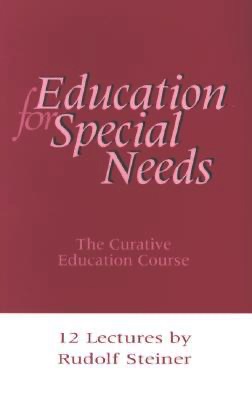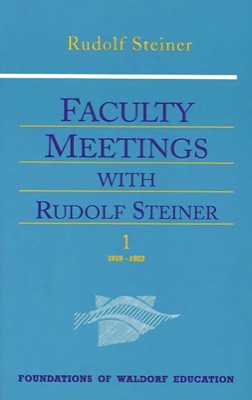The Results Of Steiner’s Curative Education
St. Christopher School

The St. Christopher School in Bristol, whose “approach is inspired by Rudolf Steiner’s educational principles and his Curative Education theory”, is to close in March 2016, due to financial problems and amid complaints of children in their charge being bullied by staff members.
According to the Bristol Post report, the school catered to 38 children with special education needs.

“The residential school [...] were judged Good by regulators Ofsted for their education department.
“But when it came to the children's home, it failed in every category, being rated Inadequate for all of them. The report from Ofsted, published at the end of August, said there were "serious and widespread failures" at the school and that children were not protected and kept safe.
“Regulators found support plans directing staff to manage the youngsters complex needs by using "intrusive and excessively restrictive interventions".
“One young person was locked within their flat and not allowed out without staff permission.
“Another six children were stopped from leaving their bedroom and other areas of the house by staff who used padded shield to obstruct the exit way and contained the young people.
“Regulators also found a youngster to have been held onto the ground in a supine position, flat on his back with his face up.
“The report said: "A high number of restraints are being used to manage young people's behaviour. Alternative strategies to reduce the use of these interventions and other restrictive techniques have not been identified by the team.
“"Not all staff are given sufficient direction from senior care managers to manage some young people's behaviour without using restrictive practices.
“"Restrictive strategies do not minimise risk or enable young people to reflect and learn. As a result, some young people's liberty is restricted."
“Inspectors said such methods of control were "not approved" for a children's home.
“They added: "They fail to consider the impact these measures have on young people's liberty and emotional well-being, particularly for young people who have severe attachment disorders or communication difficulties."
[...]
“One parent, who did not want to be named, said his son was being bullied by a carer. A spokesman for the school said the carer had been suspended immediately and that police and local authorities had been informed. An investigation has been launched.
“Staff told the Bristol Post they were being poorly managed and that one boy had been punched in the face.”
This isn't the first time that a Steiner school in the UK has had to close amid such controversy, but the bullying of children is a theme that comes back again and again when problems surface at any Steiner/Waldorf school worldwide.
These schools have a good reputation for how they deal with children with special education needs, yet there are numerous anecdotal reports that they actually struggle to cope with even common impairments such as dyslexia, so what is the pedagogy's philosophy when dealing with more serious conditions?
The “Curative Education theory” mentioned on the St Christopher school's website refers to a series of lectures given by Rudolf Steiner between the 25th of June and 7th of July 1924, and focuses on how teachers should deal with such children. As Steiner said himself, “We have, as you know, quite a number of children whose development has been arrested and whom we have now to educate — or again, to heal, in so far as this is possible.”
According to these lectures, when helping these children you need to take account of their karma: “You have here a very striking instance of the need to look also into karma, if we want to understand the child.” (First Lecture);
“It can actually happen that a human being, owing to his karma, arrives from pre-earthly existence with something that is not at all unlike this very inadequate milk jug. For his karma may not enable him, for instance, to permeate the metabolism-and-limbs system properly.” (Second Lecture);

Their incarnation, “it may quite well be that the person who is now passing his life in complete insanity has had in earlier ages a very significant incarnation, he may at one time have been a genius.” (Second Lecture);
And despite the fact that following one's karma is crucial when dealing with pupils, or anyone else for that matter, he is very clear that, “in educating backward children we are intervening in a process which in the normal course of development — were there no intervention, or were there misguided intervention — would find its fulfilment only when the child had passed through the gate of death and come to birth again in the next life. We are making, that is to say, a deep intervention in karma. Whenever we give treatment to a backward child, we are intervening in karma. And it goes without saying, we must intervene in karma in this way. For there is such a thing as right intervention.” (Second Lecture)
It's a shame staff members are reluctant to intervene with the karma of other children in their care, especially when it comes to bullying.
The right intervention often includes, or focuses solely on, curative eurythmy (eurythmy is a form of movement and dance invented by Rudolf Steiner; some specific movements can also represent letters of the alphabet): “We shall therefore have, side by side, treatment with hypophysis cerebri, arsenic baths and Curative Eurythmy. With these three working together, we shall make progress with a boy of this kind.” (Sixth Lecture)
“All this goes to show that by learning to bring the limbs into proper control, we can do much to counteract on the one hand feeble-mindedness, and on the other hand the tendency to mania. And here the way is marked out for us at once to Curative Eurythmy.” (Fifth Lecture)
“We shall give him Eurythmy exercises, not limiting ourselves to particular sounds, but doing with him whatever brings the limbs especially into movement. In this way we can strengthen the limbs in their efforts to give form to the astral body.” (Seventh Lecture)
Although karma is often to blame for the impairments these children suffer, their condition can sometimes be due to nefarious spiritual forces: “a child like the one we were considering earlier is extraordinarily difficult to deal with, the reason being that you have there before you a kind of little demon.” (Seventh Lecture)
Steiner wasn’t being figurative: he firmly believed in demons and that they can be made manifest through the use of technology, for example.

In fact, the book Faculty Meetings contains a very revealing passage (p649, 3rd July 1923):
“Dr. Steiner: That little girl L.K. in the first grade must have something really very wrong inside. There isn’t much we can do. Such cases are increasing in which children are born with a human form, but aren’t really human beings in relation to their highest I; instead, they’re filled with beings that do not belong to the human class. Quite a number of people have been born since the nineties without an I, that is, they are not reincarnated, but are human forms filled with a sort of natural demon. There are quite a large number of older people going around who are actually not human beings, but are only natural; they are human beings only in regard to their form. We cannot, however, create a school for demons.
“A teacher: How is that possible?
“Dr. Steiner: Cosmic error is certainly not impossible. The relationships of individuals coming into earthly existence have long been determined. There are also generations in which individuals have no desire to come into earthly existence and be connected with physicality, or immediately leave at the very beginning. In such cases, other beings that are not quite suited step in. This is something that is now quite common, that human beings go around without an I; they are actually not human beings, but have only a human form. They are beings like nature spirits, which we do not recognise as such because they go around in a human form. They are also quite different from human beings in regard to everything spiritual. They can, for example, never remember such things as sentences; they have a memory only for words, not for sentences.
[...]
“I do not like to talk about such things since we have often been attacked even without them. Imagine what people would say if they heard that we say there are people who are not human beings. Nevertheless, these are facts.”
Since this school's “approach is inspired by Rudolf Steiner’s educational principles and his Curative Education theory”, could any of the above have influenced how they treated these 38 children in their care?
We'll most likely never know for certain, and even if this were the case, they'd obviously never admit it. Restricting the children does go against the principles of curative eurythmy, unless they considered those children to be demons of course, as Steiner said himself, “we cannot, however, create a school for demons”.
The photo of St Christopher school was taken from the Bristol Post article.

